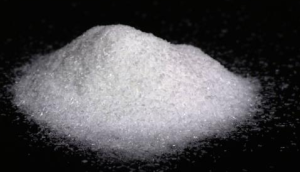Sodium Ethoxide
Molecular formula C2H5ONa
Molecular weight 68.05
CAS NO:141-52-6
Features
White or pale yellow flowable powder. Sensitive to light. Decomposes when exposed to air. The color becomes darker after long storage. Flammable. Soluble in absolute ethanol, insoluble in benzene, toluene, xylene, and ether.
Uses
Mainly used in pharmaceutical industry such as the manufacture of Benbutol, Phenylbutazone, Prednisone, Methyldopa, Tetracaine Hydrochloride, Eprazinone, Aminopterin, Pyrimethamine, Pvampicillin and so on, as well as in pesticides. It also can be used as the analytical reagent.
Storage
Store in ventilated, cool and dry warehouse; Keep away from flame and heat; Separate from oxidant and acid during storage and transportation; Handle with care, and maintain the integrity of the packaging.
Packaging sizes:20kg/bag, 80kg/steel drum
Frequently Asked Questions
Q: What is Sodium Ethoxide?
A: Sodium Ethoxide is an organic compound with a chemical formula of C2H5ONa. It is a white to slightly yellow hygroscopic powder. It is rapidly decomposed into sodium hydroxide and ethanol when it meets water, and it is soluble in absolute ethanol without decomposing. Insoluble in benzene, it is mainly used as a strong basic catalyst and ethoxylation agent, and can also be used in the organic synthesis of medicines, pesticides, spices, etc.
Q: Safety information?
Keep the container dry.
Keep away from sources of ignition – No smoking.
In case of contact with eyes, rinse immediately with plenty of water and seek medical advice.
Wear suitable protective clothing, gloves and eye and face protection.
In case of accident or if you feel unwell, seek medical advice immediately (show the lable if possible).
Q: risk term?
Highly flammable.
Reacts violently with water.
Causes burns.
| NO | Item | Specification |
| 1 | Appearance | White or pale yellow flowable powder |
| 2 | Content(total alkali) | ≥99.0% |
| 3 | Moisture | ≤0.65% |
| 4 | Free alkali(NaOH) | ≤ 1.5% |
| 5 | Sodium carbonate(Na2CO3) | ≤0.5% |
Uses of Na Ethoxide
Sodium ethoxide (C2H5ONa) is an alkoxide compound that is commonly used as a strong base and nucleophile in various chemical reactions. It is prepared by reacting sodium metal with ethanol. Sodium ethoxide has several applications in organic synthesis and as a reagent. Here are some of the common uses of sodium ethoxide:
1. Base-catalyzed reactions: Sodium ethoxide is a strong base and is often used in organic reactions that require deprotonation or elimination. It can initiate reactions such as the Williamson ether synthesis, where it helps in the formation of ethers by reacting with alkyl halides or sulfonates.
2. Alkylation and Acylation reactions: Sodium ethoxide is used in alkylations and acylations of various compounds. It can react with alkyl halides or acyl chlorides to form ethers, esters, or amides, respectively. These reactions are important in the synthesis of organic compounds, such as pharmaceuticals or specialty chemicals.
3. Condensation reactions: Sodium ethoxide is often employed in condensation reactions, such as the Claisen condensation and the Knoevenagel condensation. In the Claisen condensation, it reacts with esters or other carbonyl compounds to form β-keto esters or β-diketones, respectively. In the Knoevenagel condensation, it reacts with aldehydes or ketones to form α,β-unsaturated compounds.
4. Transesterification: Sodium ethoxide is commonly used in transesterification reactions, which involve the exchange of ester moieties between alcohol and ester molecules. It is often employed in the production of biodiesel, where it catalyzes the conversion of vegetable oil or animal fat into fatty acid methyl esters (biodiesel).
5. Desulfurization: Sodium ethoxide can be used as a reagent for desulfurization reactions, where it helps remove sulfur atoms from organic compounds. It can react with thiols or thioethers to form alkoxides or alkoxythioethers, respectively.
6. Polymerization: Sodium ethoxide can be used as a catalyst in certain polymerization reactions. For example, it can initiate the polymerization of cyclic esters, such as lactones, to produce polyesters.
